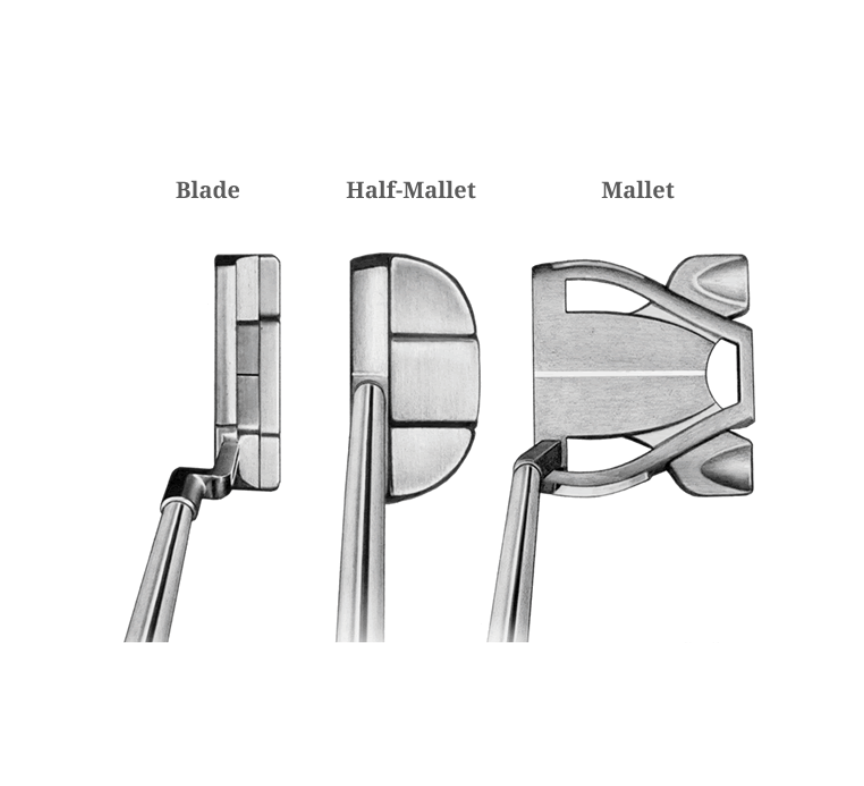
The difference between Blade, Mallet and Half-Mallet putters
Share
Blade putter
The blade putter is the most traditional type of putter and can be traced back to the earliest days of golf. It is characterized by its long, narrow clubhead, typically made from a block of metal, such as stainless steel or brass.

The simple design of the head and lack of complex elements make the blade putter an aesthetically minimalist choice. This means it has a low weight behind the head and an even weight distribution from heel to toe. This results in a fairly small sweet spot, so precision is essential when using this type of putter.
Blade putters are often lighter than other putters, which means that the player must be responsible for a large part of the pace of their stroke.
Sensitivity and precision
One of the biggest advantages of a blade putter is the excellent feedback it provides to the player. Due to the weight distribution, you can clearly feel whether you have hit the ball cleanly. This allows skilled players to adjust their technique and achieve better control over the putt.
The smaller clubhead requires an accurate swing path and clean ball contact, as any inaccuracies can result in crooked putts or a lack of control over speed, which can make it more difficult for amateurs or players with a more inconsistent putting style.
Playing style
Blade putters are well suited for players who have an arc putting style (arc stroke), where the club moves in a slight arc on both the backswing and throughswing. This style allows the player to take advantage of the blade putter's sensitivity, as the ball rolls best when the club moves naturally in a slight arc.
Mallet putter
The mallet putter is a technologically advanced type of putter that has gained great popularity among professional golfers. Unlike the blade putter, the mallet putter has a larger and heavier clubhead.

The clubhead is often designed with extra weight behind the ball, which can help keep the head stable through the swing. The shape can vary greatly, from circular or rectangular designs to more futuristic and complex geometric shapes with weights.
Some players may find the mallet putter visually distracting due to its larger head and more complex design. Traditional golfers may feel it lacks the elegance of the blade putter.
The increased weight and volume give the mallet putter a larger sweet spot, meaning it is easier for the player to get a consistent roll on the ball, even if you don't hit it exactly on center. Mallet putters also utilize modern technologies like "face-balancing," which means the clubhead remains stable and doesn't rotate as much during the swing. This reduces the risk of crooked putts, especially for players who tend to twist their wrists during the putt.
Forgiveness and less sensitivity
The biggest advantage of a mallet putter is its forgiveness. Because of its larger clubhead and weight distribution, it is easier to hit the ball cleanly, even if you don't have a perfect stroke. This makes it a good choice for players of all levels, especially those who tend to be inconsistent in their putting technique.
Because of the mallet putter's extra weight and size, it is also very stable on longer putts. This makes it easier to keep the clubhead in a straight line through the swing, which helps improve accuracy over longer distances.
While mallet putters are more forgiving, they can also be less sensitive compared to blade putters. The extra weight can make it harder to get a feel for how the ball is being struck, which can mean the player loses some of the feedback that the blade putter offers.
Playing style:
Mallet putters are ideal for players who use a straight-back, straight-through putting style. This style involves the club moving in a straight line back and forth without much rotation or arc. The mallet putter helps keep the clubhead stable and aligned, reducing the risk of error and improving accuracy on long, straight putts.
Half-mallet putter
The half-mallet putter can be described as a hybrid between the blade and mallet putter. It combines some of the best features of both types and attempts to balance weight, control and sensitivity.

Half-mallet putters typically have a clubhead that is smaller and slimmer than a traditional mallet, but heavier and larger than a blade. The shape can vary, but it often has a rounded back that adds some weight without adding too much bulk.
It is designed for players who want a little extra stability and forgiveness without sacrificing the feel and control that a blade putter offers. Half-mallet putters often have a good amount of weight behind the face, which can help provide extra power on longer putts, but they still remain slim enough to offer accuracy on shorter putts.
Feel and stability
The half-mallet putter allows the player to enjoy the best of both worlds. It offers better feel and feedback than a mallet putter, but at the same time more stability and forgiveness than a blade putter.
Versatility: This type of putter is versatile and can work well for a wide range of putting styles. Players who swing with a slight arc, as well as those with a straight swing path, can find the half-mallet putter comfortable to use.
Less disruptive design: The half-mallet putter typically has a more subdued design than a full mallet putter, which may appeal to players who want a cleaner look without compromising forgiveness.
While the half-mallet putter offers a compromise between blade and mallet putters, it also means it may not be as specialized in either of these functions. Some players prefer the full control of a blade or the full forgiveness of a mallet, depending on their preference and putting style.
Playing style
Half-mallet putters are particularly suited to players who have a putting style that falls between a straight putting style and a curved swing path. Because the half-mallet putter offers a good balance between stability and feel, it works well for golfers who need a little extra help with stability without losing too much feel in their putting stroke. This means it can suit a wider range of playing styles and is a popular all-rounder among many golfers.

